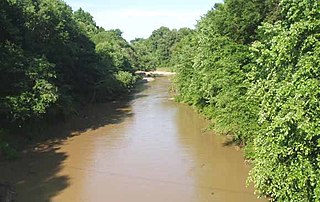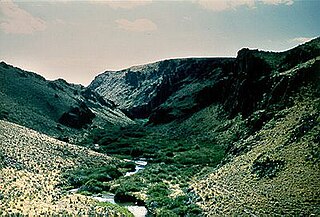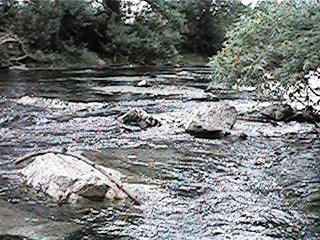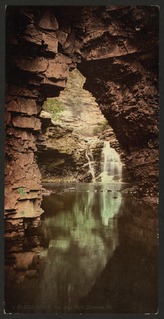This article includes a list of references, related reading or external links, but its sources remain unclear because it lacks inline citations .(July 2014) (Learn how and when to remove this template message) |
| Forked Deer River | |
|---|---|
The South Fork of the Forked Deer River near Halls, Tennessee | |
| Country | United States |
| States | Tennessee |
| Physical characteristics | |
| Main source | 230 ft (70 m) |
| River mouth | Obion River, Mississippi River |

The Forked Deer River system is the main drainage of the central portion of West Tennessee. Locals pronounce the first word of the river's name with two syllables, as in “Forkéd” ( /ˈfɔːrkɪd/ ).

Drainage is the natural or artificial removal of a surface's water and sub-surface water from an area with excess of water. The internal drainage of most agricultural soils is good enough to prevent severe waterlogging, but many soils need artificial drainage to improve production or to manage water supplies.
West Tennessee is one of the three Grand Divisions of the state of Tennessee. Of the three, it is the one that is most sharply defined geographically. Its boundaries are the Mississippi River on the west and the Tennessee River on the east. This region's boundaries have been expanded slightly to include all of Hardin County, which is bisected by the Tennessee River. The states of Kentucky and Mississippi provide the respective northern and southern boundaries, with the exception of a portion of Lauderdale County, Alabama, which lies southeast of Hardin County. The region consists of twenty-one counties.
Contents
The Forked Deer consists of various streams designated "Forked Deer" and their tributaries. Much of the Forked Deer drainage basin was initially wetlands; however much of this area has been drained and most Forked Deer tributaries have been channelized for agricultural purposes. In the mid-20th century much of this was done under the auspices of the Obion-Forked Deer Basin Authority, a Tennessee state agency. Environmental concerns have led to the cessation of channelization on a widespread basis; the federal government's "no net loss" policy regarding wetlands means that further channelization must be offset by creating new wetlands, called "mitigation lands", elsewhere.

A drainage basin is any area of land where precipitation collects and drains off into a common outlet, such as into a river, bay, or other body of water. The drainage basin includes all the surface water from rain runoff, snowmelt, and nearby streams that run downslope towards the shared outlet, as well as the groundwater underneath the earth's surface. Drainage basins connect into other drainage basins at lower elevations in a hierarchical pattern, with smaller sub-drainage basins, which in turn drain into another common outlet.
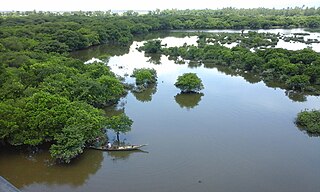
A wetland is a distinct ecosystem that is inundated by water, either permanently or seasonally, where oxygen-free processes prevail. The primary factor that distinguishes wetlands from other land forms or water bodies is the characteristic vegetation of aquatic plants, adapted to the unique hydric soil. Wetlands play a number of functions, including water purification, water storage, processing of carbon and other nutrients, stabilization of shorelines, and support of plants and animals. Wetlands are also considered the most biologically diverse of all ecosystems, serving as home to a wide range of plant and animal life. Whether any individual wetland performs these functions, and the degree to which it performs them, depends on characteristics of that wetland and the lands and waters near it. Methods for rapidly assessing these functions, wetland ecological health, and general wetland condition have been developed in many regions and have contributed to wetland conservation partly by raising public awareness of the functions and the ecosystem services some wetlands provide.

Agriculture is the science and art of cultivating plants and livestock. Agriculture was the key development in the rise of sedentary human civilization, whereby farming of domesticated species created food surpluses that enabled people to live in cities. The history of agriculture began thousands of years ago. After gathering wild grains beginning at least 105,000 years ago, nascent farmers began to plant them around 11,500 years ago. Pigs, sheep and cattle were domesticated over 10,000 years ago. Plants were independently cultivated in at least 11 regions of the world. Industrial agriculture based on large-scale monoculture in the twentieth century came to dominate agricultural output, though about 2 billion people still depended on subsistence agriculture into the twenty-first.
Much of the channelized flow is routed into the Obion River just above the mouth of that river into the Mississippi, other streams related to the system have their own mouths into the Mississippi. In some areas where the historic channels are left in place even after the bulk of the flow has been routed into new ones, the historic channels at times still demonstrate considerable flow, especially after heavy rains.

The Obion River system is the primary surface water drainage system of northwestern Tennessee.

The Mississippi River is the second-longest river and chief river of the second-largest drainage system on the North American continent, second only to the Hudson Bay drainage system. Its source is Lake Itasca in northern Minnesota and it flows generally south for 2,320 miles (3,730 km) to the Mississippi River Delta in the Gulf of Mexico. With its many tributaries, the Mississippi's watershed drains all or parts of 32 U.S. states and two Canadian provinces between the Rocky and Appalachian mountains. The main stem is entirely within the United States; the total drainage basin is 1,151,000 sq mi (2,980,000 km2), of which only about one percent is in Canada. The Mississippi ranks as the fourth-longest and fifteenth-largest river by discharge in the world. The river either borders or passes through the states of Minnesota, Wisconsin, Iowa, Illinois, Missouri, Kentucky, Tennessee, Arkansas, Mississippi, and Louisiana.
Local historians record that barges and small riverboats plied the Forked Deer in the early 19th century as far up river as the present location of the city of Jackson. Siltation from agricultural run-off eventually choked the river, and channelization became a major focus of West Tennessee politicians until the 1970s. River cutoffs have left numerous small finger lakes that are popular with local crappie and bass fishers. Otherwise, the river is a slow-moving canal with little scenic appeal.

Crappies are a genus, Pomoxis, of North American fresh water fish in the sunfish family Centrarchidae. Both species in this genus are popular pan fish.
Bass is a name shared by many species of fish. The term encompasses both freshwater and marine species, all belonging to the large order Perciformes, or perch-like fishes. The word bass comes from Middle English bars, meaning "perch".




